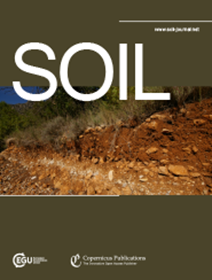Representing soil landscapes from digital soil mapping products – let the map speak for itself
IF 4.3
2区 农林科学
Q1 SOIL SCIENCE
引用次数: 0
Abstract
Abstract. Since the earliest days of soil geography, it has been clear that soils occur in more-or-less clearly mappable bodies, within which soil forming factors have been fairly homogeneous or in a regular pattern, and between which there is usually a clear transition in one or more factors. This has been the basis for polygon-based soil mapping: make a concept map from landscape elements leading to a mental model of the landscape, confirm or modify it with strategically-placed observations, find the transitions, delineate the soil bodies, and characterise them. By contrast, common methods of Digital Soil Mapping (DSM) predict per pixel over a regular grid, from training observations at pedon support. Accuracy assessment of DSM products has been at this “point” support, ignoring the existence of spatial soil bodies and the relations between pixels. Different approaches to DSM – datasets, model forms, analyst choices – result in maps with distinctly different patterns of predicted soil properties or types. Techniques from landscape ecology have been used to characterize spatial patterns of DSM products. The question remains as to how well these products reproduce the actual soil patterns at a given cartographic scale and categorical level of detail. Our approach is to let DSM maps “speak for themselves” to reveal spatial patterns. We do this by grouping pixels, either (1) by aggregation based on property homogeneity using the supercells algorithm, or (2) by segmentation based on within-block property pattern similarity, using the GeoPAT suite of computer programs. Segments can be hierarchically clustered into groups of presumed soil landscape elements. Supercells and segments can be compared to existing soil maps, other land resource maps, and expert judgement. To the extent that presumed soilscape patterns are reproduced, this is evidence that DSM has identified the soil landscape at the chosen scale. Since map users perceive patterns, and most land use decisions are for areas rather than pixels, we propose that DSM products be evaluated by their patterns, as well as by pointwise evaluation statistics.从数字土壤制图产品中呈现土壤景观——让地图为自己说话
摘要。从土壤地理学的早期开始,人们就很清楚,土壤是在或多或少可以清晰地绘制的物体中发生的,在这些物体中,土壤形成因素相当均匀或有规则的模式,它们之间通常有一个或多个因素的明显过渡。这是基于多边形的土壤制图的基础:从景观元素制作一个概念图,形成景观的心理模型,通过战略性的观察来确认或修改它,找到过渡,描绘土壤体,并描述它们的特征。相比之下,数字土壤制图(DSM)的常用方法是通过pedon支持的训练观察来预测规则网格上的每像素。DSM产品的精度评价一直在这个“点”上支撑,忽略了空间土体的存在和像元之间的关系。DSM的不同方法——数据集、模型形式、分析人员的选择——产生的地图具有预测土壤性质或类型的明显不同的模式。景观生态学的技术已被用于表征DSM产品的空间格局。问题仍然是,在给定的地图比例尺和分类细节水平上,这些产品如何很好地再现了实际的土壤模式。我们的方法是让DSM地图“为自己说话”来揭示空间模式。我们通过对像素进行分组来做到这一点,或者(1)使用supercells算法基于属性同质性进行聚合,或者(2)使用GeoPAT计算机程序集基于块内属性模式相似性进行分割。区段可以按等级聚类成假定的土壤景观要素组。超级细胞和片段可以与现有的土壤图、其他土地资源图和专家判断进行比较。在某种程度上,假定的土壤景观模式被复制,这证明DSM已经在选定的尺度上确定了土壤景观。由于地图用户感知模式,并且大多数土地利用决策是针对区域而不是像素,我们建议DSM产品通过其模式以及点评估统计来评估。
本文章由计算机程序翻译,如有差异,请以英文原文为准。
求助全文
约1分钟内获得全文
求助全文
来源期刊

Soil
Agricultural and Biological Sciences-Soil Science
CiteScore
10.80
自引率
2.90%
发文量
44
审稿时长
30 weeks
期刊介绍:
SOIL is an international scientific journal dedicated to the publication and discussion of high-quality research in the field of soil system sciences.
SOIL is at the interface between the atmosphere, lithosphere, hydrosphere, and biosphere. SOIL publishes scientific research that contributes to understanding the soil system and its interaction with humans and the entire Earth system. The scope of the journal includes all topics that fall within the study of soil science as a discipline, with an emphasis on studies that integrate soil science with other sciences (hydrology, agronomy, socio-economics, health sciences, atmospheric sciences, etc.).
 求助内容:
求助内容: 应助结果提醒方式:
应助结果提醒方式:


